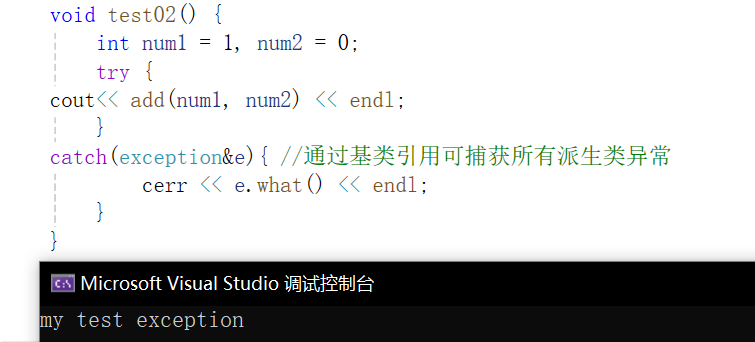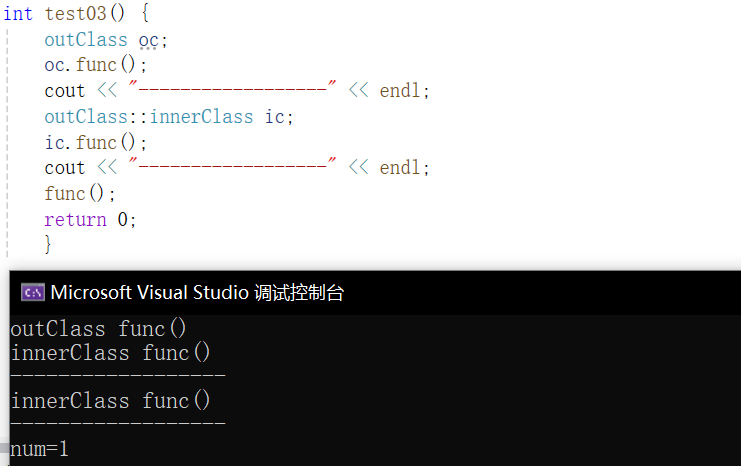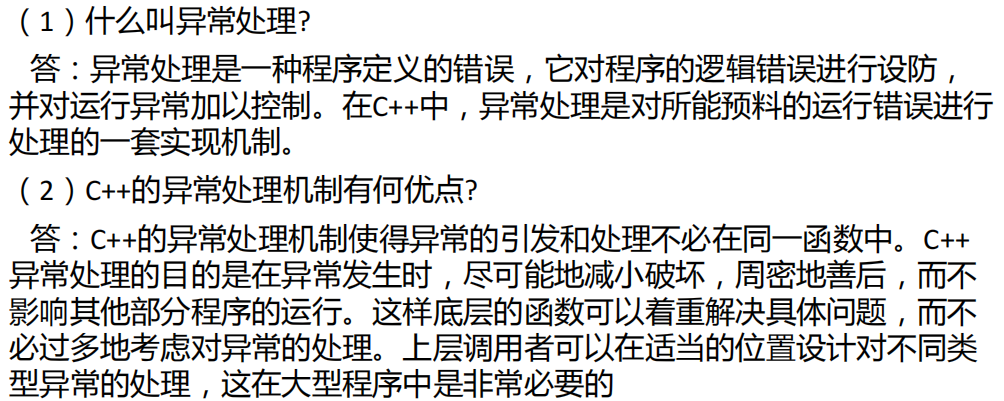【异常处理——下】
自定义异常
在异常处理——上这篇我们提到了所有异常都派生自exception类,且说明了代码中使用了try-catch-throw关键字但未添加exception头文件的原因【添:未用到what()方法】。
这篇我们先探讨的是在添加exception头文件的情况下进行继承和重载exception类来定义新的异常(比如自己加的限定条件与超过限定条件的措施)。
what() 是一个由exception类提供的公共方法,用于返回异常原因。
具体步骤:
- .h文件中
添加exception头文件
自定义类并继承exception
#pragma once
#include<iostream>
#include<exception>
using namespace std;class Exception :public exception {
public:const char* what() const throw(){ //第一个const: 返回指向常量字符串的指针//第二个const: 成员函数不会修改对象状态// throw(): 小括号里面是空的,表示该函数不会抛出任何异常return"my test exception";}
};int add(int v1, int v2);
void test02();
- .cpp中
调整add方法并明确异常点及对应反馈
补充异常捕捉细节

#pragma once
#include<iostream>
#include"myFunc.h"
using namespace std;int add(int v1, int v2) {if (v1 > 0) { //v1>0就抛出自定义异常Exception myex;throw myex;}return v1 + v2;}void test02() {int num1 = 1, num2 = 0;try {cout<< add(num1, num2) << endl;}catch(exception&e){ //通过基类引用可捕获所有派生类异常cerr << e.what() << endl;}}int main() {test02();return 0;}
练习

#pragma once
#include<iostream>
#include"myFunc.h"
using namespace std;enum index{underflow,overflow};int arr_index(int*arr,int n,int index) {if (index < 0)throw underflow;if (index > n - 1)throw overflow;return arr[index];
}int test03() {int *arr= new int[10];for (int i = 0; i < 10; i++) {arr[i] = i;}try {cout << arr_index(arr, 10,-2) << endl;}catch (index e) {if (e == underflow) cout << "index underflow!" << endl;if (e == overflow) cout << "index overflow!" << endl;}return 0;
}int main() {test03();return 0;}
嵌套类与局部类
嵌套类
嵌套类是定义在另一个类内部的类,根据是否使用static修饰符分为静态嵌套类和非静态嵌套类(即内部类)。
- 静态嵌套类:
使用static修饰,与外部类无直接关联,不能直接访问外部类的非静态成员。
实例化时无需依赖外部类对象。 - 非静态嵌套类(内部类):
可访问外部类的所有成员(包括私有成员),隐含持有外部类对象的引用。
实例化需通过外部类对象(以下实现为非静态嵌套类) - 特点:

class outClass {
public:class innerClass {public:void func();};
public:outClass::innerClass obj;void func() {cout << "outClass func()" << endl; //外部obj.func(); //内部}
};void outClass::innerClass::func() {cout << "innerClass func()" << endl; //内部
}局部类
局部类是在代码块(如方法、循环、条件语句)内部定义的类,作用域仅限于该代码块。
- 特点:
定义在方法或作用域内,仅在该块中可见。
可访问外部类的成员,但若定义在方法中,只能访问方法内的局部变量。
常用于实现特定接口或抽象类的临时实现。
void func() {class localClass { //局部类public:int num=0;void setNum(int n) {num = n;}void showNum() {cout << "num=" << num << endl;}};localClass c;c.setNum(1);c.showNum();
}
调用
int test03() {outClass oc;oc.func();cout << "------------------" << endl;outClass::innerClass ic;ic.func();cout << "------------------" << endl;func();return 0;}int main() {test03();return 0;}

梳理总结

